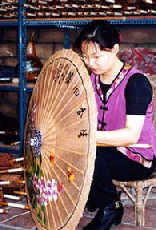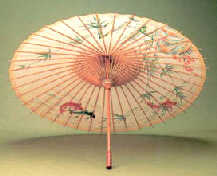China is believed to be the home to umbrellas, which are still widely used in the country. The earliest umbrellas are known to have existed at least two thousand years ago, first made of silk and later popularly paper. The Chinese waxed and lacquered their paper parasols because oil repels water. In ancient times, the frames of the umbrellas were made of mulberry bark or bamboo. Red and yellow umbrellas were used by royal families, and blue umbrellas, by the common people.
Paper Umbrellas

The best oilpaper umbrellas are generally thought to be those from Fujian and Hunan provinces, with a good reputation for its delicate craftsmanship and vivid pattern. Their bamboo frames are treated against mould and worms. The paper covers are hand-painted with flowers, birds, figures and landscapes and then coated with oil so that they are not only practical but also pretty and durable.
Though it is only a small paper umbrella like other arts, the producing craft is without any carelessness. Take Fuzhou paper umbrella for example. The rib must be made of five-year-old bamboo produced in northern Fujian Province to make it have strong tenacity and elasticity, and possess mould resistance, antiseptic property and resistance to insects by special manufacturing. An umbrella is finished via over 80 processes, and traditionally has five independent parts -- the rib, the umbrella, the head of umbrella, the shaft and painting. The umbrella surface is made of refined cotton paper with strong pulling force. Then it is treated with pure paint, again tung oil which has strong stickiness, designed with flowers and birds, figures, landscape and scenery.
Umbrellas Spreading West
The word "umbrella" comes from the Latin root word "umbra", meaning shade or shadow. Starting in the 16th century umbrella became popular to the western world, especially in rainy northern Europe. At first it was considered only an accessory for women. Then the Persian traveler and writer, Jonas Hanway (1712-1786), carried and used an umbrella publicly in England for thirty years, and he popularized the use of umbrellas among men. The first all umbrella shop was called "James Smith and Sons". The shop opened in 1830, and is still located at 53 New Oxford St., in London, England.
The early European umbrellas were made of wood or whalebone and covered with alpaca or oiled canvas. The artisans made the curved handles for the umbrellas out of hard woods like ebony, and were well paid for their efforts.
In 1852, Samuel Fox invented the steel ribbed umbrella design. Fox also founded the "English Steels Company", and claimed to have invented the steel ribbed umbrella as a way of using up stocks of farthingale stays, steel stays used in women's corsets.
After that, compact collapsible umbrellas were the next major technical innovation in umbrella manufacture, over a century later.
A Fashion

At present, umbrellas in China are made of various materials: oilpaper, cotton, silk, plastic film and nylon. They are used either against the rain or as parasols to give shade from the sun. Some are built on straight frames while others are collapsible.
The prettiest Chinese umbrellas, however, are those covered with silk, and the silk parasols of Hangzhou are veritable works of art, which also serve a practical purpose. The silk, as thin as cicada's wing and printed with landscapes, is also fixed on a bamboo frame. A parasol of Hangzhou, usually 53 centimeters or 20 inches long, weighs only 250 grams or 8.8 ounces, is very handy and makes a welcome souvenir for tourists. To protect themselves against the sun, local girls like to carry parasols with them, which have long become part of the female attire.
Umbrellas or parasols, apart from their practical uses, have also become part of the paraphernalia for the stage artists of acrobatics. A notable example is the wire-walker who uses a parasol as a balancer to keep herself on the wire.










